Zijin Yin
ConMo: Controllable Motion Disentanglement and Recomposition for Zero-Shot Motion Transfer
Apr 03, 2025Abstract:The development of Text-to-Video (T2V) generation has made motion transfer possible, enabling the control of video motion based on existing footage. However, current methods have two limitations: 1) struggle to handle multi-subjects videos, failing to transfer specific subject motion; 2) struggle to preserve the diversity and accuracy of motion as transferring to subjects with varying shapes. To overcome these, we introduce \textbf{ConMo}, a zero-shot framework that disentangle and recompose the motions of subjects and camera movements. ConMo isolates individual subject and background motion cues from complex trajectories in source videos using only subject masks, and reassembles them for target video generation. This approach enables more accurate motion control across diverse subjects and improves performance in multi-subject scenarios. Additionally, we propose soft guidance in the recomposition stage which controls the retention of original motion to adjust shape constraints, aiding subject shape adaptation and semantic transformation. Unlike previous methods, ConMo unlocks a wide range of applications, including subject size and position editing, subject removal, semantic modifications, and camera motion simulation. Extensive experiments demonstrate that ConMo significantly outperforms state-of-the-art methods in motion fidelity and semantic consistency. The code is available at https://github.com/Andyplus1/ConMo.
PGP-SAM: Prototype-Guided Prompt Learning for Efficient Few-Shot Medical Image Segmentation
Jan 12, 2025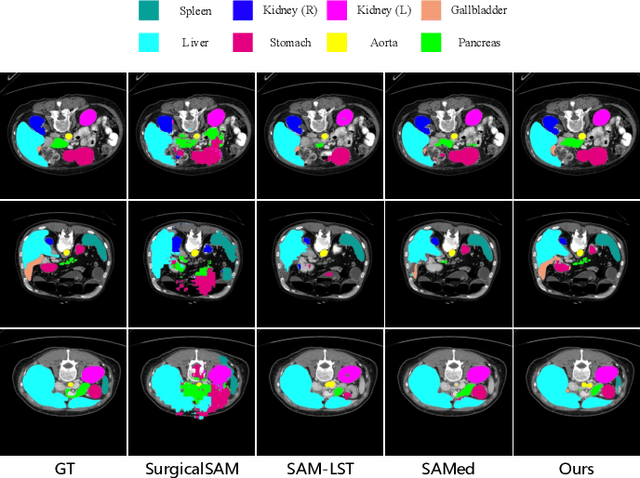



Abstract:The Segment Anything Model (SAM) has demonstrated strong and versatile segmentation capabilities, along with intuitive prompt-based interactions. However, customizing SAM for medical image segmentation requires massive amounts of pixel-level annotations and precise point- or box-based prompt designs. To address these challenges, we introduce PGP-SAM, a novel prototype-based few-shot tuning approach that uses limited samples to replace tedious manual prompts. Our key idea is to leverage inter- and intra-class prototypes to capture class-specific knowledge and relationships. We propose two main components: (1) a plug-and-play contextual modulation module that integrates multi-scale information, and (2) a class-guided cross-attention mechanism that fuses prototypes and features for automatic prompt generation. Experiments on a public multi-organ dataset and a private ventricle dataset demonstrate that PGP-SAM achieves superior mean Dice scores compared with existing prompt-free SAM variants, while using only 10\% of the 2D slices.
Polyp-E: Benchmarking the Robustness of Deep Segmentation Models via Polyp Editing
Oct 22, 2024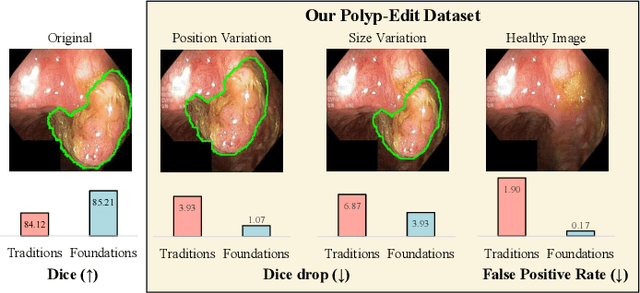

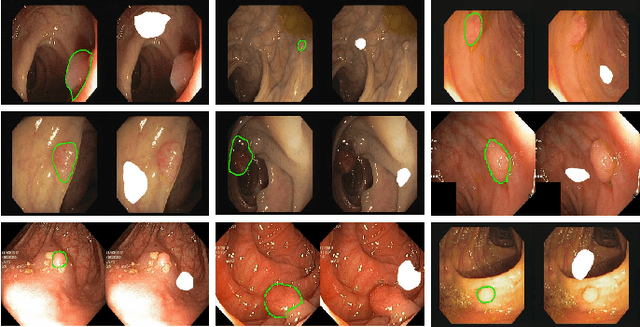
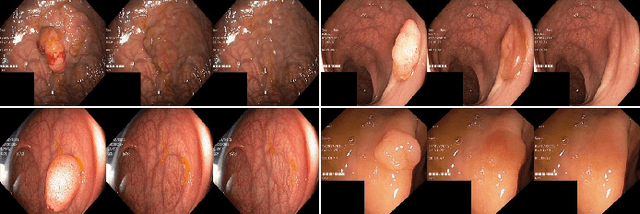
Abstract:Automatic polyp segmentation is helpful to assist clinical diagnosis and treatment. In daily clinical practice, clinicians exhibit robustness in identifying polyps with both location and size variations. It is uncertain if deep segmentation models can achieve comparable robustness in automated colonoscopic analysis. To benchmark the model robustness, we focus on evaluating the robustness of segmentation models on the polyps with various attributes (e.g. location and size) and healthy samples. Based on the Latent Diffusion Model, we perform attribute editing on real polyps and build a new dataset named Polyp-E. Our synthetic dataset boasts exceptional realism, to the extent that clinical experts find it challenging to discern them from real data. We evaluate several existing polyp segmentation models on the proposed benchmark. The results reveal most of the models are highly sensitive to attribute variations. As a novel data augmentation technique, the proposed editing pipeline can improve both in-distribution and out-of-distribution generalization ability. The code and datasets will be released.
Benchmarking Segmentation Models with Mask-Preserved Attribute Editing
Mar 10, 2024Abstract:When deploying segmentation models in practice, it is critical to evaluate their behaviors in varied and complex scenes. Different from the previous evaluation paradigms only in consideration of global attribute variations (e.g. adverse weather), we investigate both local and global attribute variations for robustness evaluation. To achieve this, we construct a mask-preserved attribute editing pipeline to edit visual attributes of real images with precise control of structural information. Therefore, the original segmentation labels can be reused for the edited images. Using our pipeline, we construct a benchmark covering both object and image attributes (e.g. color, material, pattern, style). We evaluate a broad variety of semantic segmentation models, spanning from conventional close-set models to recent open-vocabulary large models on their robustness to different types of variations. We find that both local and global attribute variations affect segmentation performances, and the sensitivity of models diverges across different variation types. We argue that local attributes have the same importance as global attributes, and should be considered in the robustness evaluation of segmentation models. Code: https://github.com/PRIS-CV/Pascal-EA.
Duplex Contextual Relation Network for Polyp Segmentation
Mar 12, 2021


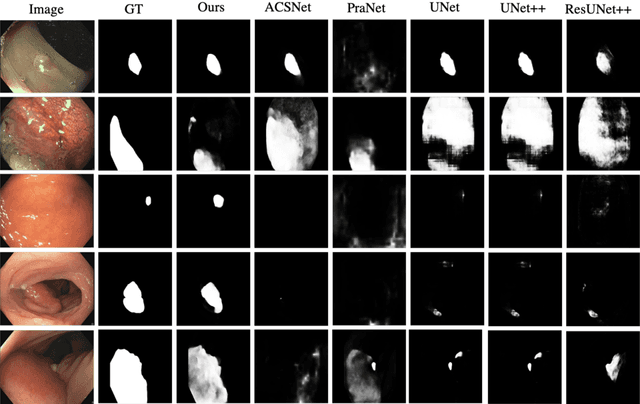
Abstract:Polyp segmentation is of great importance in the early diagnosis and treatment of colorectal cancer. Since polyps vary in their shape, size, color, and texture, accurate polyp segmentation is very challenging. One promising way to mitigate the diversity of polyps is to model the contextual relation for each pixel such as using attention mechanism. However, previous methods only focus on learning the dependencies between the position within an individual image and ignore the contextual relation across different images. In this paper, we propose Duplex Contextual Relation Network (DCRNet) to capture both within-image and cross-image contextual relations. Specifically, we first design Interior Contextual-Relation Module to estimate the similarity between each position and all the positions within the same image. Then Exterior Contextual-Relation Module is incorporated to estimate the similarity between each position and the positions across different images. Based on the above two types of similarity, the feature at one position can be further enhanced by the contextual region embedding within and across images. To store the characteristic region embedding from all the images, a memory bank is designed and operates as a queue. Therefore, the proposed method can relate similar features even though they come from different images. We evaluate the proposed method on the EndoScene, Kvasir-SEG and the recently released large-scale PICCOLO dataset. Experimental results show that the proposed DCRNet outperforms the state-of-the-art methods in terms of the widely-used evaluation metrics.
 Add to Chrome
Add to Chrome Add to Firefox
Add to Firefox Add to Edge
Add to Edge